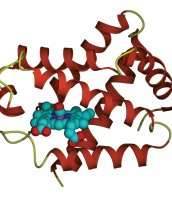Comparing complex protein networks in cells could lead to new insights in biology

(PhysOrg.com) -- Scientists have developed a way of studying cells by comparing how proteins inside them bind with one another.
The team, from Imperial College London, have developed an algorithm called MI-GRAAL that enables them to study protein-protein interaction (PPI) networks, where a cell’s proteins bind together in complex networks so that they can carry out their functions. These PPI networks are the building blocks of some of the most significant molecular processes, such as DNA replication, so comparing different PPI networks of different species could give new insights into biology.
In the study, the researchers used MI-GRAAL to compare the protein-protein interaction networks in a range of cell species, including yeast, a human cell and different strains of the herpes virus.
The team found that the PPI networks in the yeast cell and human cell were 78% identical, which surprised them as the species are at the opposite end of the evolutionary spectrum. However, they say their finding suggests that the cells in all life forms have a similar way of organising their internal structures.
The researchers also analysed different strains of the herpes virus and found that it was possible to see that they were from the same family and reconstruct their evolutionary relationships by looking at their PPI networks. Prior to this work, only comparison of DNA sequences had been able to reveal these kinds of patterns.
In addition, the researchers compared Campylobacter jejuni and Escherichia coli (E.coli), which are bacteria that cause food poisoning . They found that 56% of the PPI network in Campylobactr jejuni is present in Escherichia coli. The researchers say their work is the first step towards understanding the role of proteins in these bacteria, which are so far poorly understood.
Dr Natasa Przulj, from the Department of Computing at Imperial College London who is the lead author of the study, says:
“Scientists currently compare the genetic sequences of different species or individuals to understand more about how we’re put together and the causes of particular diseases and that has provided us with a wealth of information. However, genes are just the instruction kit that tell networks in our bodies how to produce various types of proteins and it is these proteins that actually do all the work. Now, we’ve developed a way of looking at proteins that we hope will give us a completely new perspective on cell biology. Protein-protein interactions are really complex, so we’ve put a lot of hard work into coming up with an algorithm that can analyse and align them. We think that what we’ve created should be a fantastically useful tool.”
To analyse cells, researchers enter existing data on PPI networks into a computer and they then use the MI-GRAAL algorithm to align and compare the networks across different cells.
MI-GRAAL should help scientists to work out the functions of particular proteins in cells, many of which are still poorly understood. It could also be used to compare PPIs of the networks of diseased and healthy cells, in order to determine which proteins are damaged in particular diseases and to design new treatments that target these proteins.
The study was published in the March 2011 edition of the journal Bioinformatics.
More information: bioinformatics.oxfordjournals.org/
Provided by Imperial College London














